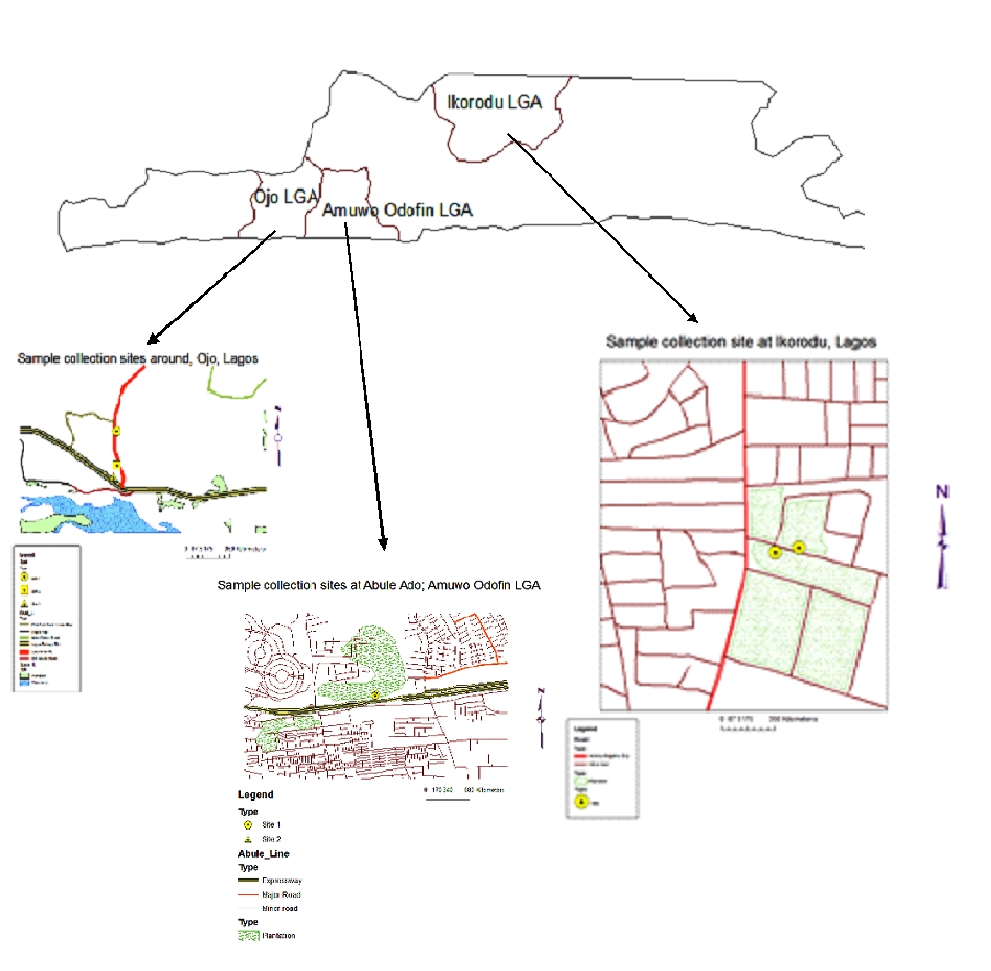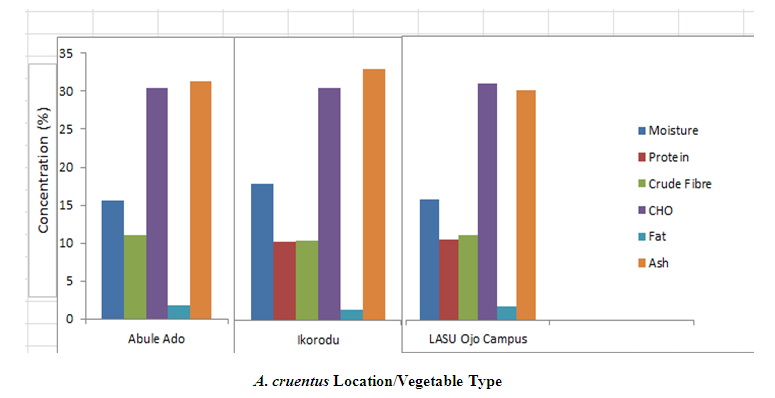-
Paper Information
- Paper Submission
-
Journal Information
- About This Journal
- Editorial Board
- Current Issue
- Archive
- Author Guidelines
- Contact Us
International Journal of Ecosystem
p-ISSN: 2165-8889 e-ISSN: 2165-8919
2019; 9(1): 6-11
doi:10.5923/j.ije.20190901.02

Proximate and Mineral Composition Analysis of the Leaves of Amaranthus cruentus and Ocimum gratissimum in Some Selected Areas of Lagos State, Nigeria
Oluwole S. O.1, Fajana O. O.2, Ogun M. L.1, Ogbe A. A.1, Ademola O. A.1
1Department of Botany, Lagos State University, Ojo, Nigeria
2Department of Biochemistry, Lagos State University, Ojo, Nigeria
Correspondence to: Oluwole S. O., Department of Botany, Lagos State University, Ojo, Nigeria.
| Email: |  |
Copyright © 2019 The Author(s). Published by Scientific & Academic Publishing.
This work is licensed under the Creative Commons Attribution International License (CC BY).
http://creativecommons.org/licenses/by/4.0/

Vegetables are commonly grown crops all over the world. Thus, this study tends to determine proximate and mineral composition analysis of two commonly consumed vegetable leaves; African spinach (Amaranthus cruentus) and scent leaf (Ocimum gratissimum) in relation to locations. The plants samples were collected from three different locations in Lagos State Nigeria, namely; Lasu campus in Ojo, Abule-Ado in Amuwo-Odofin and Agric Farm in Ikorodu area. The experiments were carried out using standard analytical procedures. Proximate analysis results revealed that the values of moisture content, crude fat, crude fibre, crude proteins, carbohydrate and ash content ranged between 15.67 - 77.43%, 1.40 - 3.67%, 2.76 - 11.00%, 2.80 - 10.53%, 5.80 - 30.87% and 6.90 - 31.37% respectively. Mineral element analysis showed that the leaf samples of A. cruentus and O. gratissimum contained appreciable amounts of Calcium (13.65 - 23.00 mg/100g), Sodium (21.10 - 34.80 mg/100g), Iron (13.03 - 28.13 mg/100g) and Zinc (31.03 - 36.53 mg/100g). Although minute quantities of Lead (0.01 – 0.02mg/100g) were recorded in the two leaf samples, Cadmium was however not detected in the leaf samples. This study has shown that the leaves of A. cruentus and O. gratissimum are rich sources of nutrients and minerals essential for optimal growth and development of human and farm animals and these nutrients and mineral compositions are relatively influenced by environmental factors and or human activities.
Keywords: Proximate and Mineral compositon, Amaranthus cruentus, Ocimum gratissimum, Location
Cite this paper: Oluwole S. O., Fajana O. O., Ogun M. L., Ogbe A. A., Ademola O. A., Proximate and Mineral Composition Analysis of the Leaves of Amaranthus cruentus and Ocimum gratissimum in Some Selected Areas of Lagos State, Nigeria, International Journal of Ecosystem, Vol. 9 No. 1, 2019, pp. 6-11. doi: 10.5923/j.ije.20190901.02.
Article Outline
1. Introduction
- Vegetables are the fresh and consumable portions of herbaceous plants, which can be eaten wholly or in parts, raw or cooked as part of main dishes [1]. Vegetables may be edible fruits, seeds, flowers, leaves, stems, roots, bulbs and tubers [2]. Vegetables are important sources of macro and micro elements which are highly important for the maintenance of good health and prevention of diseases [3]. Most of the commonly eaten vegetables are the succulent leaves of plants; they are eaten as supplementary foods, side dishes or in soup as condiments, or eaten with other main dishes [4]. Leafy vegetables are regular ingredients in the diet of the average home in most tropical countries of Africa. These vegetables are valuable and cheap sources of important food types especially in rural areas where they contribute substantial quantities of proteins, minerals, vitamins, fibres and oils which are usually in short supply in daily menus [5]. In Nigeria, different types of leafy vegetables are eaten singly or in combination by different ethnic groups and they have been reported to contain ingredients which are useful in building up and repairing body tissues [6]. In rural areas of most developing countries, where poverty and natural disaster wreak havoc, the majority of the populace still depends heavily on starchy food as main sources of energy and protein thereby leading to the prevalence of protein deficiency amongst the people [7].Furthermore, minerals cannot be produced by human and farm animals and as such they must eat mineral rich plants including leafy vegetables and water [8]. Vegetables also serve as buffers for acidic compounds produced during food digestion [9].Two of the most commonly eaten vegetables in Nigeria are Occimum gratissimum and Amaranthus cruentus. O. gratissimum (Scent leaf) belongs to the family Lamiaceae. Its vernacular names in Nigeria include Efirin (Yoruba), Ahuji (Igbo), Aramogbo (Edo), and Daidoya (Hausa) [10]. It is an erect small plant not more than 1m high distributed throughout the tropic and subtropics regions of the world. It is cultivated in homes and leaves are used widely as vegetables, condiments and in traditional medicine to treat upper respiratory tract problems, skin diseases, pneumonia, cough, headaches, fever, conjunctivitis and as mosquito repellants [11]. A. cruentus is a fast growing vigorous erect annual plant that belongs to the family Amaranthaceae. The plant can grow up to 2m and is often cultivated in home gardens as leafy vegetables in Nigeria. In traditional medicine the leaves are employed as laxatives, tapeworm expellant and anti- tumor.However, whether the A. Cruentus and Ocimum gratissimum leaves nutritional compositions are affected by different planting locations as a result of varying soil factors or as a result of some other environmental factors like ecological, have not been much worked upon.Thus, locations determine the properties of soil in different places and this may leads to different compositions of the soil nutrients [12,13] and then could lead to varying chemical constituents of the same plants grown on it.Environmental conditions in different areas could contribute to varying soil properties and varying compositions of the plants.The essence of this study was to evaluate the proximate composition and mineral constituents of two important and commonly consumed leafy vegetables viz: A. cruentus and O. gratissimum in relation to locations.
2. Materials and Methods
- Collection of Plant Materials
 | Figure 1. Map of Lagos State Showing Sample Locations |
 | Figure 2. Image showing O. gratissimum plants |
 | Figure 3. Image showing A. cruentus plants |
3. Results and Discussion
3.1. Proximate Composition
- The percentage moisture contents of the analysed leafy vegetables revealed that A. cruentus and O. gratissimum contained 16.11 and 75.73% respectively (Table 1 and Figure 4, 5). These values were higher than those reported earlier for some Nigerian leafy vegetables by Onwordi et al. [6]. A. cruentus contained higher ash content (30.88%) when compared to O. gratissimum (7.12%) (Table 1). The ash contents obtained are similar to those of O. gratissimum reported by Fagboun et al. [16] and A. hybridus [17]. Ash content is of significant importance in foods as they account for the mineral constituents [18]. The crude protein contents of A.cruentus and O. gratissimum reported in this study (Table 1 and Figure 4, 5) were low when compared to the protein contents of some leafy vegetables in other studies by Onwordi et al. [6], Asaolu et al. [19] and Fagboun et al. [16].
|
 | Figure 4. Comparison of Mean proximate concentration of O. gratissimum from different locations |
 | Figure 5. Comparison of Mean proximate concentration of A. cruentus from different locations |
3.2. Mineral Composition
- The mean concentration value of calcium of A. cruentus (20.83mg/g) was higher than that of O. gratissimum (14.40 mg/g) (Table 2 and Figure 6). The calcium levels in the leaves studied were lower than the values reported in some green leafy vegetables eaten locally in Nigeria [19]. Calcium has been reported to aid the growth and maintenance of bone, teeth and muscles [25]. Zinc contents varied from 31.60 mg/g (O. gratissimum) to 34.33mg/g (A. cruentus) (Table 2). These values were higher when compared to the values obtained from the mineral analysis of some vegetables as confirmed by Fagboun et al. [16]. Zinc is known to play a significant role in the normal functioning of the immune system and it is also associated with protein metabolism [26]. The investigated leafy vegetables are good sources of zinc because they are well above 6.23mg/g recommended Borgert et al. [27].
|
 | Figure 6. Comparison of Mean mineral concentration (mg/g) of the two leafy vegetables from different locations |
4. Conclusions
- Findings from this study have shown that the investigated leafy vegetables are highly nutritious source of food. Both vegetables contains varying amount of nutrients and minerals in relation to locations. These vegetables also contains very low amount of heavy metals and fat which suggest that if consumed in sufficient amount, they would help to maintain normal growth and development. It therefore, recommends the consumption of these two vegetables from the different locations studied as they are safe and highly rich in nutrients. Thus, vegetables contribute a number of minerals and enable their continuous availability from time to time. Minerals are important vital body functions such as acid base and water balance.However, further researches should be conducted on the effects of weather or season on the nutritional composition of the leaves of A. cruentus and O. gratissimum and or whether the nutritional compositions will be affected when cooked or eaten raw.
ACKNOWLEDGEMENTS
- Authors extend gratitude to Prof. Osonubi, O. for his scholarly advise during the compilation of the manuscript, and lastly to our anonymous reviewers for their editorial insights.
 Abstract
Abstract Reference
Reference Full-Text PDF
Full-Text PDF Full-text HTML
Full-text HTML
